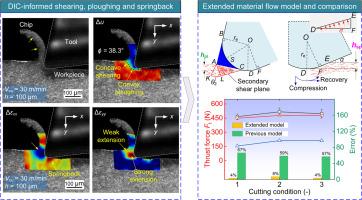DIC-informed microscale elastoplastic flow states in machining
IF 9.4
1区 工程技术
Q1 ENGINEERING, MECHANICAL
International Journal of Mechanical Sciences
Pub Date : 2025-09-27
DOI:10.1016/j.ijmecsci.2025.110892
引用次数: 0
Abstract
Characterizing material flow states is essential for understanding metal cutting mechanisms and improving machine tool performance, particularly near the tool cutting edge (TCE). Accurately modeling these flow states is challenging due to the rapid and severe deformations in this region. To address this, a hybrid approach combining experimental observation and theoretical modeling was developed for machining of Inconel 718 alloy. An in-situ imaging system with high-speed filming capability was set up on a CNC lathe. The captured images were processed using a digital image correlation (DIC) algorithm based on the Gauss-Newton nonlinear iterative method to obtain incremental displacement and strain fields. DIC analysis revealed the evolution of the shearing zone from concave-convex to near-linear, the transition of the stagnation point/zone ahead of the TCE, the dynamic sticking-sliding contact at the chip-tool interface, and the ploughing-induced stretching-like springback at the tool flank face. These observations supported the development of an extended slip-line field model for cutting with rounded TCE, incorporating microscale elastoplastic material flow states into forces prediction. Orthogonal cutting tests with various uncut chip thickness (UCT) and cutting velocities validated the hybrid model. Compared with a previous one, the proposed approach reduced the average prediction error of forces from 21.6% to 14.5% in the cutting direction and from 61% to 5.1% in the thrust direction. This study provides a comprehensive characterization of microscale material flow states and significant process signatures, offering guidance for machine tool design and manufacturing process optimization.

机械加工中的微尺度弹塑性流态
表征材料流状态对于理解金属切削机制和提高机床性能至关重要,特别是在刀具切削刃(TCE)附近。由于该地区的快速和严重变形,准确地模拟这些流动状态具有挑战性。针对这一问题,提出了一种实验观察与理论建模相结合的加工方法。在数控车床上建立了具有高速拍摄能力的原位成像系统。采用基于高斯-牛顿非线性迭代法的数字图像相关(DIC)算法对捕获的图像进行处理,获得增量位移场和应变场。DIC分析揭示了剪切带由凹-凸向近线性的演化过程,切屑-刀具界面的动态粘-滑接触,刀具侧面的犁削拉伸回弹等特征。这些观察结果支持了用于圆形TCE切割的扩展滑移线场模型的发展,该模型将微尺度弹塑性材料流状态纳入力预测。不同未切削切屑厚度和切削速度的正交切削试验验证了混合模型的有效性。与之前的方法相比,该方法将切削方向的平均预测误差从21.6%降低到14.5%,将推力方向的平均预测误差从61%降低到5.1%。该研究提供了微尺度材料流状态的综合表征和重要的过程特征,为机床设计和制造过程优化提供指导。
本文章由计算机程序翻译,如有差异,请以英文原文为准。
求助全文
约1分钟内获得全文
求助全文
来源期刊

International Journal of Mechanical Sciences
工程技术-工程:机械
CiteScore
12.80
自引率
17.80%
发文量
769
审稿时长
19 days
期刊介绍:
The International Journal of Mechanical Sciences (IJMS) serves as a global platform for the publication and dissemination of original research that contributes to a deeper scientific understanding of the fundamental disciplines within mechanical, civil, and material engineering.
The primary focus of IJMS is to showcase innovative and ground-breaking work that utilizes analytical and computational modeling techniques, such as Finite Element Method (FEM), Boundary Element Method (BEM), and mesh-free methods, among others. These modeling methods are applied to diverse fields including rigid-body mechanics (e.g., dynamics, vibration, stability), structural mechanics, metal forming, advanced materials (e.g., metals, composites, cellular, smart) behavior and applications, impact mechanics, strain localization, and other nonlinear effects (e.g., large deflections, plasticity, fracture).
Additionally, IJMS covers the realms of fluid mechanics (both external and internal flows), tribology, thermodynamics, and materials processing. These subjects collectively form the core of the journal's content.
In summary, IJMS provides a prestigious platform for researchers to present their original contributions, shedding light on analytical and computational modeling methods in various areas of mechanical engineering, as well as exploring the behavior and application of advanced materials, fluid mechanics, thermodynamics, and materials processing.
 求助内容:
求助内容: 应助结果提醒方式:
应助结果提醒方式:


